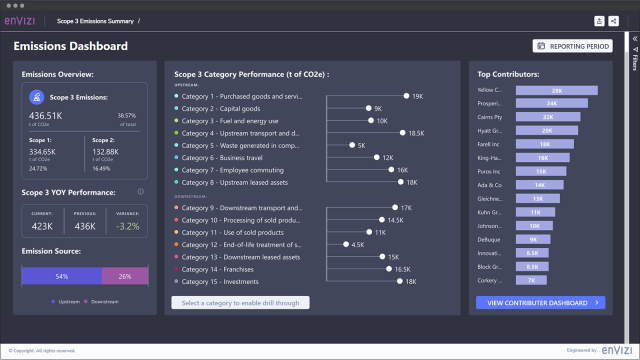IBM Envizi software module
Scope 3 emissions accounting and reporting platform
Calculate upstream and downstream emissions quickly and accurately
Book your ESG Optimiser demo hereUse AI to take the work out of gathering Scope 3 data and improve reporting accuracy
Scope 3 GHG Accounting & Reporting software uses AI to simplify emissions calculations. Flexible reporting tools deliver value chain insights and streamline disclosures, leveraging embedded Scope 3 emissions factor libraries to make calculations more efficient.
Calculate Scope 3 upstream and downstream GHG emissions across an organisation using all methods supported by the GHG Protocol including spend-based, average-data, hybrid and supplier-specific.

Module features
Robust calculation engine
Scope 3 emissions are automatically calculated using the relevant GHG Protocol calculation method. AI-driven Natural Language Processing (NLP) models support data categorisation for spend-based calculations, and emissions factors are drawn from embedded libraries.
Calculation accuracy summary
Summaries of calculation accuracy by data type help improve your sustainability reporting accuracy year-on-year and address any data governance issues that arise.
PowerReports
Customisable Microsoft Power BI-embedded PowerReports generate data visualisations to help keep stakeholders informed of carbon footprint reduction progress.
Would you like to see how ESG Optimiser – our fully integrated ESG data and analytics platform works?
Book a 30 minute demo, and chat with an ESG data expert
Scope 3 GHG emissions are a huge opportunity to engage your suppliers in accelerating decarbonisation in your business
This IBM Envizi software module takes the work out of calculating Scope 3 GHG emissions data while simultaneously improving reporting accuracy.
Audit ready, finance grade data built on GHG protocol, traceable to source data
Maximise efficiency with global standardisation of units and currencies
Removes administration managing publicly available or commercially licensed GHG emission factors in one place
Full guidance for each of the 15 different Scope 3 emissions calculation methodologies.
Use forecasting and modelling tools to optimise future GHG emissions reduction

If you haven’t seen an overview of the complete ESG Optimiser solution, with 9 integrated platform modules, an additional 5 specialist tools, and a comprehensive implementation and support service, just click here.
Your ESG team
Ikano Insight’s team of expert sustainability consultants will guide your business through all aspects of sustainability strategy, from data management to GHG calculations, framework reporting to legislative audits and compliance, and software implementation to business performance improvement.
Our team are there to help you every step of the way, as little or as much as you need, on your sustainability journey.
Head of Sustainability
Peter Jones
peter.jones@insight.ikano
Snr Sustainability Business Analyst
Innes Christison
innes.christison@insight.ikano
Sustainability Business Analyst
Emily Blenkley
emily.blenkley@insight.ikano
Peter Jones
Head of Sustainability
Innes Christison
Snr Sustainability Business Analyst
Emily Blenkley
Sustainability Business Analyst
Frequently asked questions
What are Scope 3 GHG emissions?
Scope 3 GHG emissions refer to the indirect greenhouse gas emissions associated with an organisation’s activities that occur outside its own boundaries. These emissions result from the entire value chain, including suppliers, customers, transportation, waste, and more.
Why is measuring Scope 3 emissions important?
Measuring Scope 3 emissions is crucial for a comprehensive understanding of an organisation’s environmental impact. These emissions often account for the majority of a company’s carbon footprint, and addressing them is essential for effective climate change mitigation and sustainability efforts.
What are the different categories of Scope 3 emissions?
Scope 3 emissions are categorised into 15 different categories as defined by the Greenhouse Gas Protocol. Some common categories include purchased goods and services, transportation and distribution, business travel, employee commuting, and waste generated.
What challenges may companies face when measuring Scope 3 emissions?
Measuring Scope 3 emissions can be complex and challenging due to data availability, reliability, and the need for cooperation from suppliers and other stakeholders. Additionally, varying calculation methodologies and regional emission factors can introduce complexities.
Are Scope 3 emissions included in carbon footprint reporting?
Yes, Scope 3 emissions are typically included in an organisation’s carbon footprint reporting to provide a comprehensive overview of its total greenhouse gas emissions impact.
Book a demo

Let’s chat!
If you’d like to chat with us to see how we can help you achieve your sustainability goals, including measurement, reporting and compliance, just pick a time that suits you in Peter’s calendar.
Review your sustainability objectives, challenges and see which platform modules would match your needs.
Get in touch
Let’s chat!
If you’d like to chat with us to see how we can help you achieve your sustainability goals, including measurement, reporting and compliance, just pick a time that suits you in Peter’s calendar.
Review your sustainability objectives, challenges and see which platform modules would match your needs.
Related modules
Scope 1 & 2 GHG emissions accounting and reporting
Streamline calculations for worry-free reporting
Sustainability target setting and tracking
Set and track your carbon-reduction targets to speed decarbonisation
Supply chain intelligence
Engage your suppliers and streamline Scope 3 Category 1 emission calculations






